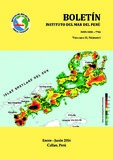Por favor, use este identificador para citar o enlazar este ítem:
https://hdl.handle.net/20.500.12958/3084Registro completo de metadatos
| Campo DC | Valor | Lengua/Idioma |
|---|---|---|
| dc.contributor.author | Ledesma Rivera, Jesús | |
| dc.contributor.author | León, Violeta | |
| dc.contributor.author | Flores Gonzáles, Georgina | |
| dc.contributor.author | Sarmiento, Miguel | |
| dc.contributor.author | Robles Cáceres, Carlos | |
| dc.date.accessioned | 2017-01-25T14:01:48Z | |
| dc.date.available | 2017-01-25T14:01:48Z | |
| dc.date.issued | 2016 | |
| dc.identifier.citation | Bol Inst Mar Perú 31(1), 2016: p. 98-104 | es_ES |
| dc.identifier.uri | https://hdl.handle.net/20.500.12958/3084 | |
| dc.description | Boletín IMARPE vol. 31, nº 1, 2016; p. 98-104 | es_ES |
| dc.description.abstract | Se exploran las relaciones funcionales del ecosistema marino y los parámetros hidroquímicos en el estrecho de Bransfield, con el objetivo de mejorar la comprensión de las interacciones ambiente y el recurso krill (Euphausia superba), considerado el crustáceo más importante y abundante en el ecosistema marino antártico. Las mayores cantidades de clorofila-a se presentaron en la zona norte del área evaluada, coincidiendo con la mayor distribución del krill en la zona costera de las islas Decepción y Elefante, con valores de 0,5 a 1,0 μg/L. Los contenidos de oxígeno disuelto mostraron una isolínea mínima de 6,25 mL/L entre los 250 y 300 m de profundidad, habituales con respecto a investigaciones anteriores. Los silicatos estuvieron influenciados por la dinámica física del estrecho de Bransfield, con isolíneas de 70,0 μM disminuyendo en zonas intermedias generándose núcleos de 30,0 a 50,0 μM. | es_ES |
| dc.description.abstract | ABSTRACT: This study explores the functional relationships of the marine ecosystem in the Bransfield Strait and hydrochemical parameters, aiming to improve the understanding of the environment and resource interactions krill (Euphausia superba), considered the most important and abundant crustacean in the Antarctic marine ecosystem. The greatest amounts of chlorophyll-a is presented in the north of the area evaluated, coinciding with the largest distribution of krill in the coastal area of Deception Islands and Elephant with values of 0.5 to 1.0 μg/L chlorophyll-a. The dissolved oxygen content isoline showed a minimum of 6.25 mL/L between the 250 and 300 m depth, normal with respect to previous. The silicates were influenced by the physical dynamics of the Bransfield Strait, with isolines of 70.0 μM and decreasing in intermediate areas generating cores from 30.0 to 50.0 μM. | |
| dc.language.iso | spa | es_ES |
| dc.publisher | Callao | es_ES |
| dc.relation.ispartofseries | Boletín IMARPE;Vol. 31 n° 1, 2016 | |
| dc.rights | info:eu-repo/semantics/openAccess | es_ES |
| dc.rights.uri | https://creativecommons.org/licenses/by/4.0/ | |
| dc.source | Instituto del Mar del Perú - IMARPE | es_ES |
| dc.source.uri | Repositorio Digital IMARPE | es_ES |
| dc.subject | Estrecho De Bransfield | es_ES |
| dc.subject | Antártida | es_ES |
| dc.subject | Oceanografía Física | es_ES |
| dc.subject | Condiciones Hidroquímicas | es_ES |
| dc.title | Condiciones hidroquímicas del mar frente al estrecho de Bransfield, verano austral 2007 (ANTAR XVII). | es_ES |
| dc.title.alternative | Hydrochemical sea condition front Bransfield Strait, southern summer 2007 (ANTAR XVII) | es_ES |
| dc.type | info:eu-repo/semantics/article | es_ES |
| Aparece en las colecciones: | Boletín 31(1), 2016 | |
Ficheros en este ítem:
| Fichero | Descripción | Tamaño | Formato | |
|---|---|---|---|---|
| Boletin 31(1)-12.pdf | 4,53 MB | Adobe PDF |  Visualizar/Abrir |
Este ítem está sujeto a una licencia Creative Commons Licencia Creative Commons

